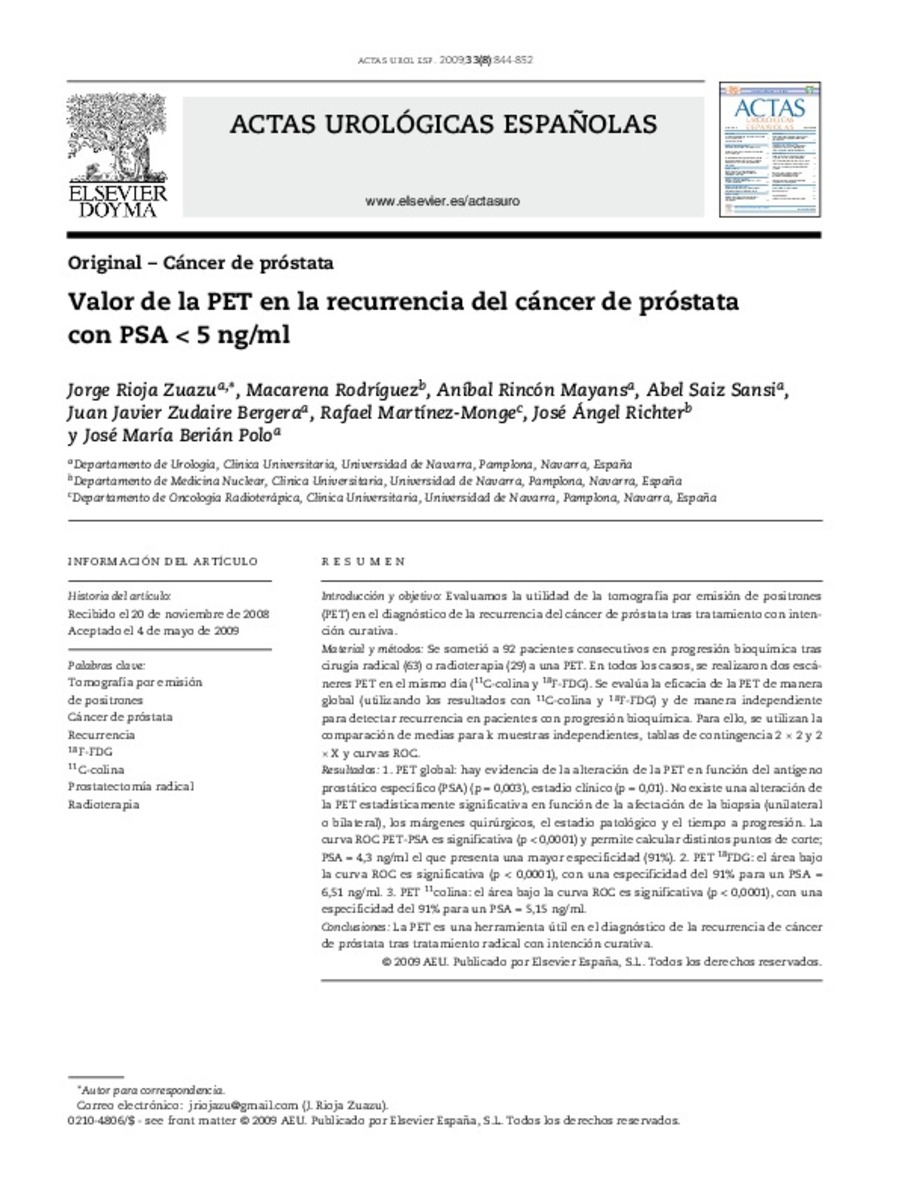Full metadata record
| DC Field | Value | Language |
|---|---|---|
| dc.creator | Rioja-Zuazu, J. (Jorge) | - |
| dc.creator | Rodriguez, M. (Macarena) | - |
| dc.creator | Rincon-Mayans, A. (Anibal) | - |
| dc.creator | Sainz-Sansi, A. (Abel) | - |
| dc.creator | Zudaire-Bergera, J.J. (Juan Javier) | - |
| dc.creator | Martinez-Monge, R. (Rafael) | - |
| dc.creator | Richter, J.A. (José Ángel) | - |
| dc.creator | Berian-Polo, J.M. (José María) | - |
| dc.date.accessioned | 2012-07-18T12:02:44Z | - |
| dc.date.available | 2012-07-18T12:02:44Z | - |
| dc.date.issued | 2009 | - |
| dc.identifier.citation | Rioja Zuazu J, Rodriguez M, Rincon Mayans A, Sansi AS, Zudaire Bergera JJ, Martinez-Monge R, et al. Valor de la PET en la recurrencia del cáncer de próstata con PSA < 5 ng/ml. Actas Urol Esp 2009 Sep;33(8):844-852. | es_ES |
| dc.identifier.issn | 0210-4806 | - |
| dc.identifier.uri | https://hdl.handle.net/10171/22912 | - |
| dc.description.abstract | We intend to evaluate the usefulness of PET scans in diagnosing recurrent prostate cancer after a curative attempt using radical treatment. MATERIAL AND METHODS: 92 consecutive prostate cancer patients in biochemical progression following radical surgery (63) or radiation treatment (29) were studied with positron emission tomography (PET). In all cases two scans were performed in the same day (11C-choline and 18F-FDG). PET efficacy was evaluated both globally (by employing the results achieved with both 11C-choline and 18F-FDG) and using both radiotracers independently to detect recurrence in patients with biochemical progression. For this purpose, we used comparison of means for k-independent samples, 2 x 2 and 2 x X contingency tables and ROC curves. RESULTS: 1. Global PET: there is evidence of PET alteration regarding the PSA level (P=.003): the clinical stage (P=.01). There are no statistically significant PET alterations regarding the affected biopsy (uni or bilateral), surgical margins, pathological stage and time to progression. ROC curve PET-PSA is statistically significant (P< .0001) permitting calculation of different cut-off points, with a specificity of 91% (highest) for a PSA of 4.3 ng/ml. 2. PET 18FDG: the area under the ROC curve is statistically significant (P< .0001) with a specificity of 91% for a PSA of 6.51 ng/ml. 3. PET 11choline: the area under the ROC curve is statistically significant (P< .0001) with a specificity of 91% for a PSA of 5.15 ng/ml. CONCLUSIONS: PET is a useful tool for diagnosing prostate cancer recurrence after a curative attempt using radical treatment. | es_ES |
| dc.language.iso | spa | es_ES |
| dc.publisher | Elsevier España | es_ES |
| dc.rights | info:eu-repo/semantics/openAccess | es_ES |
| dc.subject | Positron emission tomography | es_ES |
| dc.subject | Prostate cancer | es_ES |
| dc.subject | Radical prostatectomy | es_ES |
| dc.subject | Radiation treatment | es_ES |
| dc.title | Valor de la PET en la recurrencia del cáncer de próstata con PSA < 5 ng/ml | es_ES |
| dc.title.alternative | Usefulness of PET scans in diagnosing recurrent prostate cancer. Prostate with PSA level < 5 ng/ml | es_ES |
| dc.type | info:eu-repo/semantics/article | es_ES |
| dc.type.driver | info:eu-repo/semantics/article | es_ES |
| dc.identifier.doi | http://dx.doi.org/10.1016/S0210-4806(09)72870-0 | es_ES |
Files in This Item:
Statistics and impact
Items in Dadun are protected by copyright, with all rights reserved, unless otherwise indicated.






